|

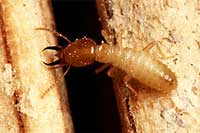 Termites have biting mouthparts and their soft bodies are small,
rarely over 10 mm in length. They typically inhabit dark nests and
tunnels, only venturing out when the winged individuals emerge to
leave their parent colony, when constructing shelter or, in the
case of grass-eaters, when harvesting grass stems. The bodies of
flying individuals are dark, while termites which remain in the
nest are whitish with only their heads being lightly pigmented.
The deciduous wings of termites are long Termites have biting mouthparts and their soft bodies are small,
rarely over 10 mm in length. They typically inhabit dark nests and
tunnels, only venturing out when the winged individuals emerge to
leave their parent colony, when constructing shelter or, in the
case of grass-eaters, when harvesting grass stems. The bodies of
flying individuals are dark, while termites which remain in the
nest are whitish with only their heads being lightly pigmented.
The deciduous wings of termites are long and slender, in two pairs
that are similarly sized and shaped. The wings are quickly shed
after flight with a simple body flick when the swarming termites
find a new nest site, pair up and dig in. The remnant of the wing
is a distinct triangular scale. and slender, in two pairs
that are similarly sized and shaped. The wings are quickly shed
after flight with a simple body flick when the swarming termites
find a new nest site, pair up and dig in. The remnant of the wing
is a distinct triangular scale.

Swarm intelligence: As social insects, termites live in colonies that number from several
hundred to several million individuals at maturity. They are a prime
example of decentralised, self-organised systems using swarm intelligence
and use this cooperation to exploit food sources and environments
that could not be available to any single insect acting alone. A
typical colony contains workers, soldiers, and reproductive individuals
of both sexes, often containing several egg-laying queens.
Classified to food: Termites are generally grouped according to their feeding behaviour.
Thus the commonly used general groupings are: Subterranean, Soil-feeding,
Drywood, Dampwood and Grass eating. Of these, subterraneans and
drywoods are primarily responsible for damage to structures.
Friends with Benefits: All termites eat cellulose in its various forms as plant fibre.
Cellulose is a rich energy source (think of wood fires), but difficult
to digest. Termites rely primarily upon symbiotic protozoa (metamonads)
called trichonympha and other microbes in their gut to digest the
cellulose for them, absorbing the end products for their own use.
The gut protozoa in turn rely on symbiotic bacteria embedded on
their surfaces to produce some of the necessary digestive enzymes.
This relationship is one of the finest examples of mutualism among
animals. Most so called "higher termites", especially
in the Family Termitidae can produce their own cellulase enzymes.
However, they still retain a rich gut fauna with bacteria dominant.
Fungi farmers: Some species of termite practise farming! They maintain a 'garden'
of specialized fungi, which are nourished by the excrement of the
insects. When the fungi in turn are eaten, their spores pass undamaged
through the guts of the termites, to complete the cycle by germinating
in the fresh faecal pellets.
Quite the builders: In some regions, notably arid tropical savannas, termites construct
extremely large and elaborate mounds which house their colonies.
These mounds can have very 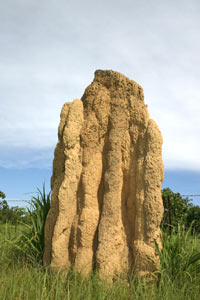 distinctive forms, such as those of the
compass termite, which build tall wedge-shaped mounds with the long
axis oriented approximately north-south. This orientation has been
experimentally shown to ease the termites' workload in regulating
the mound's internal temperature. Some mounds can reach heights
of 6 meters, but most species build mounds of less than two meters.
The structure of these mounds can be quite complex, arguably more
complex than many human dwellings, providing thermal mass, solar
collection, defence, atmospheric control, food storage, housing
and areas for fungal agriculture. distinctive forms, such as those of the
compass termite, which build tall wedge-shaped mounds with the long
axis oriented approximately north-south. This orientation has been
experimentally shown to ease the termites' workload in regulating
the mound's internal temperature. Some mounds can reach heights
of 6 meters, but most species build mounds of less than two meters.
The structure of these mounds can be quite complex, arguably more
complex than many human dwellings, providing thermal mass, solar
collection, defence, atmospheric control, food storage, housing
and areas for fungal agriculture.
Eating everything: Because of their wood-eating habits, termites sometimes do great
damage to buildings and other wooden structures. Their habit of
remaining concealed often results in their presence being undetected
until the timbers are severely damaged and exhibit surface changes.
Once termites have entered a building they do not limit themselves
just to wood, also damaging paper, cloth, carpets, and other plant
or cellulose-based materials.
-------------------------------------------------------------------------------------------------------------------
Social structure and behaviour
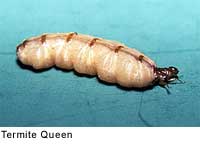 Queen: At maturity, a primary queen can lay several thousand eggs a day. In physogastric species, the queen adds an extra set of ovaries with each moult, resulting in a greatly distended abdomen and increased fecundity. The distended abdomen increases her size in some species to as much as 10 centimetres, hundreds of times the original size, effectively immobilizing her. In times where the queen must be moved to a new chamber it requires a group effort to move her whereby hundreds of workers are required to push her. The queen is widely believed to be a primary source of pheromones useful in colony integration. As a reward for attending workers a juice is secreted from the queen's posterior for the workers to drink. Queen: At maturity, a primary queen can lay several thousand eggs a day. In physogastric species, the queen adds an extra set of ovaries with each moult, resulting in a greatly distended abdomen and increased fecundity. The distended abdomen increases her size in some species to as much as 10 centimetres, hundreds of times the original size, effectively immobilizing her. In times where the queen must be moved to a new chamber it requires a group effort to move her whereby hundreds of workers are required to push her. The queen is widely believed to be a primary source of pheromones useful in colony integration. As a reward for attending workers a juice is secreted from the queen's posterior for the workers to drink.
King: The king remains only slightly bigger than an average termite and continues to mate with the queen for life. This is especially unusual since ant societies have colonies with only a queen which mates once with the male and stores his gametes for life. Males in ant colonies die immediately after mating, unlike termite male alates which become kings and live with the queen. The alate caste, also referred to as the reproductive caste, are the only termites with well developed eyes. In some cases termite mounds have been opened to find multiple queens and kings in a single nest chamber. Immature alates still going through incomplete metamorphosis form a sub-caste in certain species of termites, functioning as supplementaries. Supplementaries have the ability to replace a dead primary reproductive, but this integration into primary reproductive status is rare.
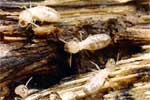 Workers: Worker termites undertake the labours of foraging, food storage, brood, nest maintenance and a portion of the defence effort in some species. Workers are the only caste in the colony with the ability to digest cellulouse in wood due to the presence of trichonympha in the digestive tract. They then regurgitate the digested cellulose to the other castes since only they have the mandibles to chew wood and the digestion required. This symbiosis is integral since without these microbes entire nests would starve. This weakness is sometimes used in pest control to destroy termites by killing the trichonympha chemically. Termite workers are blind due to undeveloped eyes. The workers are responsible for creating the nest walls using a combination of dung, wood chips and saliva. Some species have been known to create such durable walls that industrial machinery has been damaged in an attempt to break their tall mounds. Some African and Australian species have mounds that can tower above a man's height. The nest is designed by workers with special rooms for fungal gardens, brooding, water collection, reproductive chambers, and tunnel networks that effectively provide air conditioning. In some species the workers have additional symbiosis with insects known as termitophiles where juice is created for the termites and housing is provided for the termitophiles. This is similar to cow ants, which farm aphids for juice and provide a home for the aphid. Workers: Worker termites undertake the labours of foraging, food storage, brood, nest maintenance and a portion of the defence effort in some species. Workers are the only caste in the colony with the ability to digest cellulouse in wood due to the presence of trichonympha in the digestive tract. They then regurgitate the digested cellulose to the other castes since only they have the mandibles to chew wood and the digestion required. This symbiosis is integral since without these microbes entire nests would starve. This weakness is sometimes used in pest control to destroy termites by killing the trichonympha chemically. Termite workers are blind due to undeveloped eyes. The workers are responsible for creating the nest walls using a combination of dung, wood chips and saliva. Some species have been known to create such durable walls that industrial machinery has been damaged in an attempt to break their tall mounds. Some African and Australian species have mounds that can tower above a man's height. The nest is designed by workers with special rooms for fungal gardens, brooding, water collection, reproductive chambers, and tunnel networks that effectively provide air conditioning. In some species the workers have additional symbiosis with insects known as termitophiles where juice is created for the termites and housing is provided for the termitophiles. This is similar to cow ants, which farm aphids for juice and provide a home for the aphid.
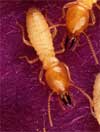 Soldiers: The soldier caste has anatomical and behavioural specializations, primarily against ant attack. Many have jaws so enlarged that they cannot feed themselves, but instead, like juveniles, are fed by workers. The tropical Nasutus species have soldiers with the ability to exude noxious liquids through either a horn-like nozzle (nasus) or simple hole in the head (fontanelle). Many species are classified using the characteristics of the soldiers' heads, mandibles or nasus due to distinct differences with each species. Among the drywood termites, a soldier's enlarged (phragmotic) head can be used to block their narrow tunnels. Termite soldiers mostly require the aid of the nest to perform war duty since they have undeveloped eyes which are blind. They use their heads, nasus or mandibles to defend tunnels effectively. With a tunnel blocked so effectively it can rebuff attacks from many ants. Usually more soldiers stand by behind the initial soldier so once the first one falls another soldier will take his place. In cases where the intrusion is coming from a breach that is larger than the soldier's head, defense requires special formations where soldiers form a phalanx-like formation around the breach blindly biting at intruders or shooting toxic glue from the nasus. This formation involves self sacrifice because once the breach is repaired during fighting by the workers no return is provided causing the death of all the defenders. Termites undergo incomplete metamorphosis, with their freshly hatched young taking the form of tiny termites that grow without significant morphological changes. Some species of termite have been known to have small groups of extremely large soldiers (3*normal size). Though their purpose is unknown speculation indicates that they are an elite class that defends only the inner tunnels of the mound. This is the commonly accepted belief because their size would be of great use in the large interior tunnels. Even when provoked, these large soldier termites will not defend themselves but merely travel deeper into the mound. Soldiers: The soldier caste has anatomical and behavioural specializations, primarily against ant attack. Many have jaws so enlarged that they cannot feed themselves, but instead, like juveniles, are fed by workers. The tropical Nasutus species have soldiers with the ability to exude noxious liquids through either a horn-like nozzle (nasus) or simple hole in the head (fontanelle). Many species are classified using the characteristics of the soldiers' heads, mandibles or nasus due to distinct differences with each species. Among the drywood termites, a soldier's enlarged (phragmotic) head can be used to block their narrow tunnels. Termite soldiers mostly require the aid of the nest to perform war duty since they have undeveloped eyes which are blind. They use their heads, nasus or mandibles to defend tunnels effectively. With a tunnel blocked so effectively it can rebuff attacks from many ants. Usually more soldiers stand by behind the initial soldier so once the first one falls another soldier will take his place. In cases where the intrusion is coming from a breach that is larger than the soldier's head, defense requires special formations where soldiers form a phalanx-like formation around the breach blindly biting at intruders or shooting toxic glue from the nasus. This formation involves self sacrifice because once the breach is repaired during fighting by the workers no return is provided causing the death of all the defenders. Termites undergo incomplete metamorphosis, with their freshly hatched young taking the form of tiny termites that grow without significant morphological changes. Some species of termite have been known to have small groups of extremely large soldiers (3*normal size). Though their purpose is unknown speculation indicates that they are an elite class that defends only the inner tunnels of the mound. This is the commonly accepted belief because their size would be of great use in the large interior tunnels. Even when provoked, these large soldier termites will not defend themselves but merely travel deeper into the mound.
All text is available under the terms
of the GNU Free Documentation License
|